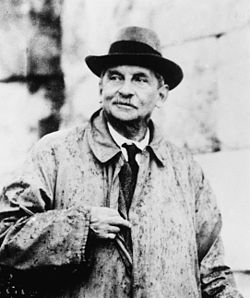Arthur Evans
From Wikipedia, the free encyclopedia
For other uses, see Arthur Evans (disambiguation).
| Sir Arthur Evans | |
|---|---|
 | |
| Born | 8 July 1851 Nash Mills, Hertfordshire |
| Died | 11 July 1941 (aged 90) Youlbury, Oxfordshire |
| Nationality | British |
| Fields | Archaeology, museum management, journalism, statesmanship, philanthropy |
| Institutions | Ashmolean Museum |
| Alma mater | University of Oxford |
| Known for | Excavations at Knossos; developing the concept of Minoan civilization |
| Influences | John Evans Heinrich Schliemann Edward Augustus Freeman William Gladstone |
| Influenced | V. Gordon Childe; all archaeologists and historians of the ancient Aegean region |
| Notable awards | Fellow of the Royal Society,[1]knighted 1911 |
Sir Arthur John Evans FRS[1] FREng[2] (/ˈɛvənz/; 8 July 1851 – 11 July 1941) was an English archaeologist and pioneer in the study of Aegean civilization in the Bronze Age. He is most famous for unearthing the palace of Knossos on the Greek island of Crete. Evans continued Heinrich Schliemann's concept of a Mycenaean civilization, but found that he needed to distinguish another civilization, the Minoan, from the structures and artifacts found there and throughout the eastern Mediterranean.[3] Evans was also the first to define Cretan scripts Linear A and Linear B, as well as an earlier pictographic writing.
Although not a professional statesman or soldier, and probably never a paid agent of the government, he nevertheless negotiated or played a role in negotiating unofficially with foreign powers in the Balkans and Middle East. He was, on request of the revolutionary organizations of the peoples of the Balkans, a significant player in the formation of the nation of Yugoslavia.
No comments:
Post a Comment